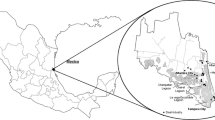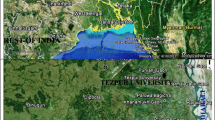Abstract
Source profiles (fractional mass abundances and uncertainties) for use in chemical mass balance (CMB) source apportionment are reported for soil dust from unpaved roads and desert lands. The objectives were to add to the library of source composition profiles available for CMB studies, and to provide data on the variation in wind-blown dust composition between particle sizes and geographical locations. Samples were resuspended and sampled through PM1, PM2.5 and PM10 inlets onto filters, then chemically analyzed for 40 elements, seven ions and eight carbon fractions. Air quality management would benefit from technology that can distinguish soil dust from sites in different geographical locations and sites with different land uses. Five geographical clusters representing Ft Bliss, TX, Dona Ana County, NM, Ft Irwin, CA, the west desert and the Canyonlands, UT, were examined. Distinctive differences were found between sites within a cluster and these differences were comparable to the differences between cluster averages. Some sites showed small differences in chemical composition between particle sizes, but these differences were less than the differences observed between nearby geographical locations. Dust emissions from sites with uniform geology have distinctive source profiles that may be useful for CMB receptor modeling. Heterogeneous regions, defined by land management boundaries, will require extensive field sampling to develop representative composite source profiles.
Similar content being viewed by others
References
Bevington, P. R.: 1969, Data Reduction and Error Analysis for the Physical Sciences, McGraw Hill, New York.
Brook, J. R., Vega, E. and Watson, J. G.: 2003, ‘Receptor methods’, in Particulate Matter Science for Policy Makers, A NARSTO Assessment, part 2, ch 7, NARSTO, Pasco, WA, pp. 7-1-7-48. www.cgenv.com/Narsto.
Chow, J. C. and Watson, J. G.: 1999, ‘Ion chromatography in elemental analysis of airborne particles’, in S. Landsberger and M. Creatchman (eds), Elemental Analysis of Airborne Particles, Vol. 1, Gordon and Breach Science, Amsterdam, pp. 97-137.
Chow, J. C. and Watson, J. G.: 2002a, ‘Review of PM2.5 and PM10 apportionment for fossil fuel combustion and other sources by the chemical mass balance receptor model’, Energy & Fuels 16(2), 222-260.
Chow, J. C. and Watson, J. G.: 2002b, ‘PM2.5 carbonate concentrations at regionally representative interagency monitoring of protected visual environment sites’, J. Geophysical Res. 107(D21), ICC 6-1-ICC 6-9, doi: 10.1029/2001JD000574.
Chow, J. C. and Watson, J. G.: 1994, Contemporary Source Profiles for Geological Material and Motor Vehicle Emissions, Report No. DRI 2625.2F, prepared for U.S. EPA, Office of Air Quality Planning and Standards, Research Triangle Park, NC, by Desert Research Institute, Reno, NV.
Chow, J. C., Watson, J. G., Ashbaugh, L. L. and Magliano, K. L.: 2003, ‘Similarities and differences in PM10 chemical source profiles for geological dust from the San Joaquin Valley, California’, Atmos. Environ. 37(9,10), 1317-1340, doi: 10.1016/S1352-2310(02)01021-X.
Chow, J. C., Watson, J. G., Crow, D., Lowenthal, D. H. and Merrifield, T.: 2001, ‘Comparison of IMPROVE and NIOSH carbon measurements’, Aerosol Sci. Technol 34(1), 23-34.
Chow, J. C., Watson, J. G., Houck, J. E., Pritchett, L. C., Rogers, C. F., Frazier, C. A., Egami, R. T. and Ball, B. M.: 1994, ‘A laboratory resuspension chamber to measure fugitive dust size distributions and chemical compositions’, Atmos. Environ. 28(21), 3463-3481.
Chow, J. C., Watson, J. G., Lowenthal, D. H., Solomon, P. A., Magliano, K. L., Ziman, S. D. and Richards, L. W.: 1992, ‘PM10 source apportionment in California’s San Joaquin Valley’, Atmos Environ. 26A(18), 3335-3354.
Chow, J. C.,Watson, J. G., Pritchett, L. C., Pierson, W. R., Frazier, C. A. and Purcell, R. G.: 1993, ‘The DRI thermal/optical reflectance carbon analysis system: description, evaluation and applications in U.S. air quality studies’, Atmos. Environ. 27A(8), 1185-1201.
Cooper, J. A., Redline, D. C., Sherman, J. R., Valdovinos, L. M., Pollard, W. L., Scavone, L. C. and West, C. R.: 1987, PM 10 Source Composition Library for the South Coast Air Basin, Volume I: Source Profile Development Documentation, Final Report, South Coast Air Quality Management District, El Monte, CA.
Core, J. E. and Houck, J. E.: 1987, Pacific Northwest Source Profile Library Sampling and Analytical Protocols, Oregon Department of Environmental Quality, Portland, OR.
Eltayeb, M. A. H., van Grieken, R. E., Maenhaut, W. and Annegarn, H. J.: 1993, ‘Aerosol-soil fractionation for Namib Desert samples’, Atmos. Environ. 27A(5), 669-678.
EPA: 1999, ‘40 CFR Part 51-Regional haze regulations: final rule’, Federal Register 64(126):35714-35774.
Etyemezian, V., Gillies, J., Kuhns, H., Nikolic, D., Watson, J., Veranth, J., Labban, R., Seshadri, G., Gillette, D.: 2002, ‘Field testing and evaluation of dust deposition and removal mechanisms’, Final Report on Western States Air Resources Council, Lake Oswego, OR.
Flocchini, R. G., Cahill, T. A., Pitchford, M. L., Eldred, R. A., Feeney, P. J. and Ashbaugh, L. L.: 1981, ‘Characterization of particles in the Arid West’, Atmos. Environ. 15(10/11), 2017-2030.
Friedlander, S. K.: 1973, ‘Relating particulate pollution to sources: case of the Los Angeles aerosol’, in Proceedings of the Third International Clean Air Congress, Dusseldorf, Germany, 1973, pp. C78-C80.
Fung, K. K., Chow, J. C. and Watson, J. G.: 2002, ‘Evaluation of OC/EC speciation by thermal manganese dioxide oxidation and the IMPROVE method’, J. Air & Waste Management Assoc. 52(11), 1333-1341.
Gillies, J. A., Abu-Allaban, M., Kuhns, H., Etyemezian, V., Durham, C., Labban, R. and Veranth, J.: 2003, ‘Assessment of the contribution of Fort Bliss, Texas to regional PM10’, manuscript in preparation.
Gordon, G. E.: 1988, ‘Receptor models’, Environ. Sci. Technol. 22(10), 1132-1142.
Hopke, P. K. (ed.): 1991, Receptor Modeling for Air Quality Management, Elsevier, Amsterdam.
Houck, J. E., Chow, J. C. and Ahuja, M. S.: 1989a, ‘The chemical and size characterization of particulate material originating from geological sources in California’, in J. G. Watson (ed.), Transactions, Receptor Models in Air Resources Management, Air & Waste Management Association, Pittsburgh, PA, pp. 322-333.
Houck, J. E., Chow, J. C., Watson, J. G., Simons, C. A., Pritchett, L. C., Goulet, J. M. and Frazier, C. A.: 1989b, Determination of Particle Size Distribution and Chemical Composition of Particulate Matter from Selected Sources in California, Report no. A6-175-32 prepared for California Air Resources Board, Sacramento, CA, by OMNI Environmental Services Inc., Beaverton, OR, and Desert Research Institute, Reno, NV.
Kuykendal, W. B., Brooks, G., Waddell, J. T. and Butler, W. A.: 1990, ‘Database for characterizing the chemical composition of source emissions for particulate matter and volatile organic compounds’, in C. V. Mathai (ed.), Transactions, Visibility and Fine Particles, Air and Waste Management Association, Pittsburgh, PA, pp. 447-455.
McDonald, E. V. and Caldwell, T. G.: 2003, Integration of Science and Management: Integration of Revegetation Project and Soil Hydrology at the NTC Fort Irwin, California, Charis Corporation Subcontract No. GS-012FG-A.
Perry, K. D., Cahill, T. A., Eldred, R. A. and Dutcher, D. D.: 1997, ‘Long-range transport of North African dust to the Eastern United States’, J. Geophysical Res. 102(D10), 11225-11238.
Pitchford, M. L., Flocchini, R. G., Draftz, R. G., Cahill, T. A., Ashbaugh, L. L. and Eldred, R. A.: 1981, ‘Silicon in submicron particles in the Southwest’, Atmos. Environ. 15, 321-333.
Shareef, G. S., Butler, W. A., Bravo, L. A. and Stockton, M. B.: 1988, Air Emissions Species Manual, Volume 2: Total Suspended Particulate Species Profile, Report no. EPA-450/2-88-003B, U.S. Environmental Protection Agency, Research Triangle Park, NC.
Stokes, W. L.: 1986, Geology of Utah, Utah Geological and Mineral Survey and Utah Museum of Natural History, Salt Lake City, UT.
Watson, J. G.: 1979, ‘Chemical element balance receptor model methodology for assessing the sources of fine and total suspended particulate matter in Portland, Oregon’, Ph.D. Dissertation, Oregon Graduate Center, Beaverton, OR.
Watson, J. G.: 1984, ‘Overview of receptor model principles’, J. Air Pol.Control Assoc. 34(6), 619-623.
Watson, J. G.: 2002a, ‘Visibility: science and regulation’, J. Air & Waste Management Assoc. 52(6), 628-713.
Watson, J. G.: 2002b, ‘Visibility: science and regulation - A Summary of the 2002 Critical Review’, EM, (June)36-43.
Watson, J. G. and Chow, J. C.: 2001, ‘Source characterization of major emission sources in the Imperial and Mexicali Valleys along the U.S./Mexico Border’, Sci. Total Environ. 276(1-3), 33-47.
Watson, J. G., Chow, J. C. and Frazier, C. A.: 1999, ‘X-ray Fluorescence analysis of ambient air samples’, in S. Landsberger and M. Creatchman (eds.), Elemental Analysis of Airborne Particles, vol. 1, Gordon and Breach Science, Amsterdam, pp. 67-96.
Watson, J. G., Chow, J. C. and Houck, J. E.: 2001, ‘PM2.5 Chemical source profiles for vehicle exhaust, vegetative burning, geological material, and coal burning in Northwestern Colorado during 1995’, Chemosphere 43(8), 1141-1151.
Watson, J. G., Chow, J. C., Lowenthal, D. H., Pritchett, L. C., Frazier, C. A., Neuroth, G. R. and Robbins, R.: 1994a, ‘Differences in the carbon composition of source profiles for diesel-and gasoline-powered vehicles’, Atmos. Environ. 28(15), 2493-2505.
Watson, J. G., Chow, J. C., Lu, Z., Fujita, E. M., Lowenthal, D. H. and Lawson, D. R.: 1994b, ‘Chemical mass balance source apportionment of PM10 during the Southern California Air Quality Study’, Aerosol Sci. Technol. 21(1), 1-36.
Watson, J. G., Chow, J. C. and Pace, T. G.: 1991, ‘Chemical mass balance’, in P. K. Hopke (ed.), Receptor Modeling for Air Quality Management, Elsevier, New York, pp. 83-116.
Watson, J. G., Cooper, J. A. and Huntzicker, J. J.: 1984, ‘The effective variance weighting for least squares calculations applied to the mass balance receptor model’, Atmos. Environ. 18(7), 1347-1355.
Watson, J. G., Zhu, T., Chow, J. C., Engelbrecht, J. P., Fujita, E. M., Wilson, W. E.: 2002, ‘Receptor modeling application framework for particle source apportionment’, Chemosphere 49(9), 1093-1136
Yi, S. M., Lee, E. Y. and Holsen, T. M.: 2001, ‘Dry Deposition Fluxes and size distributions of heavy metals in Seoul, Korea during yellow-sand events’, Aerosol Sci. Technol. 35(1), 569-576.
Author information
Authors and Affiliations
Rights and permissions
About this article
Cite this article
Labban, R., Veranth, J.M., Chow, J.C. et al. Size and Geographical Variation in PM1, PM2.5 and PM10: Source Profiles from Soils in the Western United States. Water, Air, & Soil Pollution 157, 13–31 (2004). https://doi.org/10.1023/B:WATE.0000038855.96607.c6
Issue Date:
DOI: https://doi.org/10.1023/B:WATE.0000038855.96607.c6




